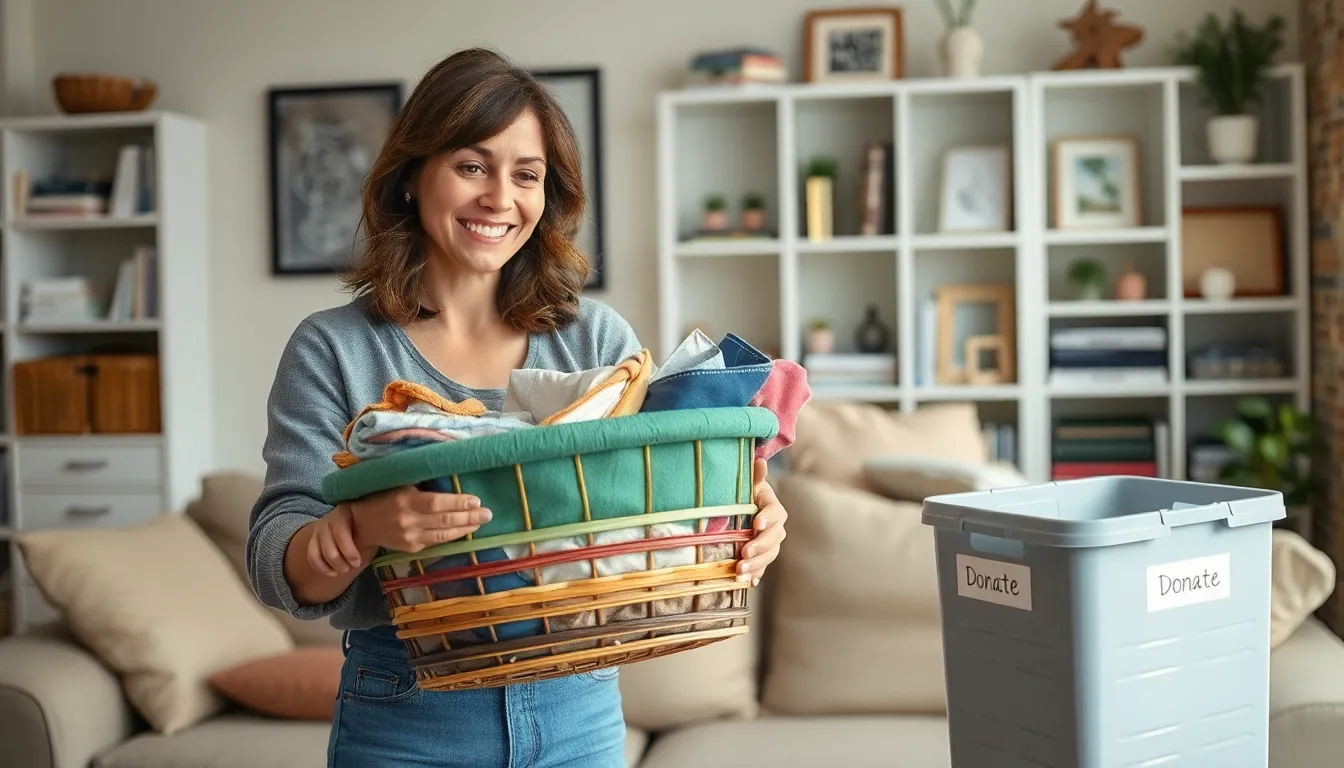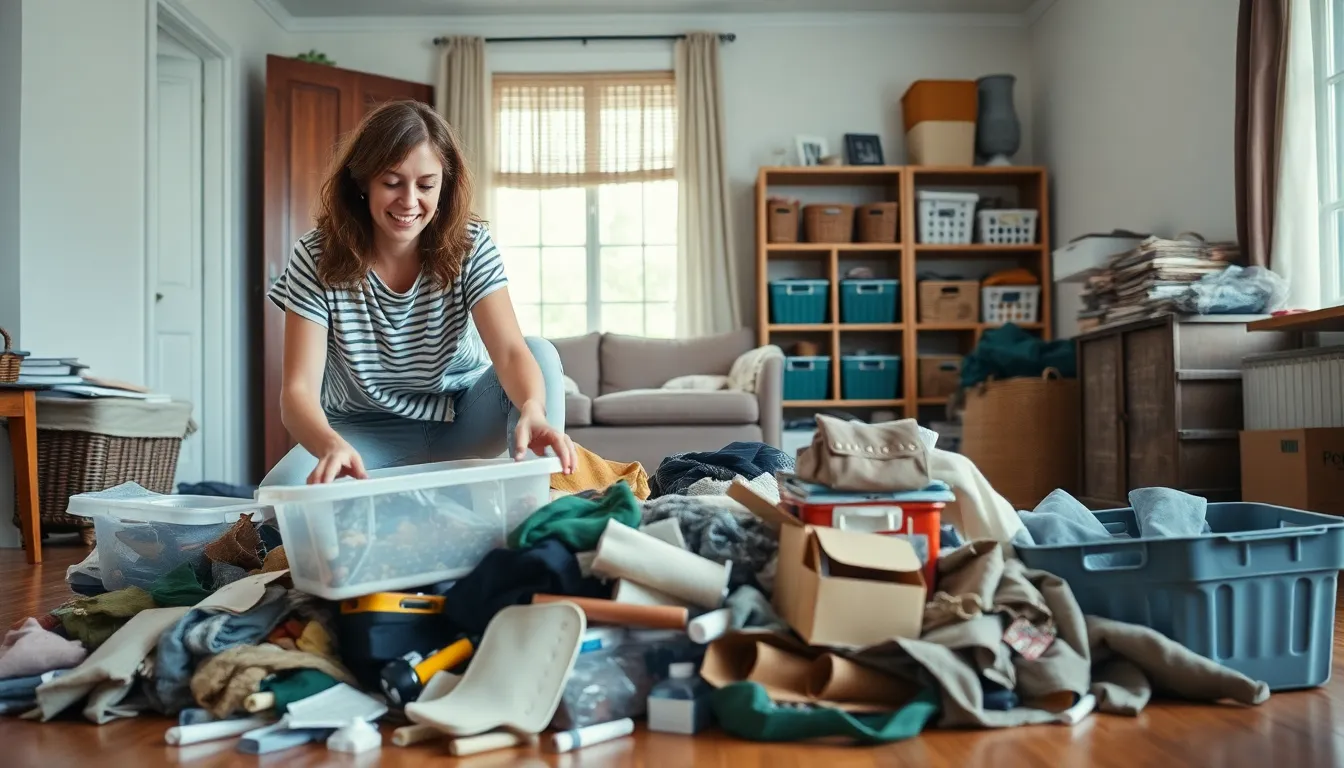Home clutter can feel like an uninvited guest that just won’t leave. It sneaks up on you—one stray sock here, a stack of unread magazines there—and before you know it, your living space resembles a scene from a reality show about hoarding. But fear not! Tackling that chaos doesn’t have to be a Herculean task.
Table of Contents
ToggleUnderstanding Home Clutter
Home clutter often stems from various everyday habits that accumulate over time. Recognizing these patterns can simplify the process of decluttering.
Common Causes of Clutter
Disorganization frequently arises from a lack of designated storage spaces. Items without a home tend to scatter across surfaces. Impulsive purchases also contribute significantly, with many people acquiring things they seldom use. Additionally, procrastination plays a role; individuals might delay organizing tasks, allowing clutter to build. Lastly, emotional attachments can result in keeping items longer than necessary, despite their lack of utility.
Psychological Impact of Clutter
Clutter affects mental health, often leading to feelings of stress and anxiety. Disorderly environments can distract individuals, hindering focus and productivity. Over time, excessive clutter may foster a sense of overwhelm, making it challenging to complete even simple tasks. Clearing away clutter can enhance clarity and create a more positive atmosphere, allowing for better decision-making. Ultimately, addressing clutter alleviates some psychological burdens, promoting overall well-being.
Effective Home Clutter Fix Strategies


Effective strategies simplify the process of managing home clutter. Several techniques help reduce the mess and build a more organized environment.
Decluttering Techniques
Sort items by category, making decisions easier on what to keep. Donations to charities create space and help others simultaneously. Utilize the “One In, One Out” rule, ensuring balance in possessions. Set a timer, dedicating specific intervals for decluttering tasks, ensuring productivity without overwhelm. Implement the Four-Box Method: keep, donate, trash, and relocate items for effective sorting. Lastly, tackle one area at a time to maintain focus and achieve visible progress quickly.
Organizing Tips
Create designated spaces for frequently used items, promoting easy access and reducing clutter build-up. Use baskets and bins for out-of-sight storage, which keeps items organized and visually appealing. Label containers, enhancing quick identification of contents. Align shelves by category to streamline organization and improve accessibility. Maintain a regular cleaning schedule with daily habits to prevent clutter from returning. Incorporate vertical storage solutions, maximizing available space and enhancing organization efficiency.
Tools and Resources for Home Organization
Utilizing the right tools and resources significantly enhances home organization efforts. These help transform chaotic spaces into functional areas.
Storage Solutions
Effective storage solutions maximize available space while minimizing clutter. Bins and baskets offer versatile options for organizing various items, from toys to magazines. Shelving units provide vertical storage, making use of walls rather than floors. Drawer organizers maintain order within drawers by separating utensils from office supplies. Labeling containers ensures everyone knows where items belong, reducing future clutter. Choosing furniture with built-in storage can also create dual-purpose spaces that are both practical and stylish.
Mobile Applications for Clutter Management
Mobile applications can streamline clutter management processes. Apps like Todoist assist users in creating decluttering tasks with reminders. Additionally, Magic Home allows individuals to take inventory of belongings and track what to keep or discard. Some applications offer virtual organizing tips tailored to specific spaces, turning chaos into clarity. Users can also find inspiration through platforms like Pinterest, featuring organizational ideas that motivate them to tackle their clutter effectively. Monitoring progress through these technologies fosters ongoing commitment to maintaining an organized living space.
Maintaining a Clutter-Free Home
Keeping a clutter-free home involves daily commitment and periodic evaluations. By integrating simple habits and routines, individuals promote an organized living space.
Daily Habits to Implement
Establishing daily routines significantly reduces clutter accumulation. Begin each day by spending just 10 minutes tidying up common areas. Create designated spots for everyday items, ensuring each belongs in its specific place. Adopt the “One In, One Out” rule to manage new acquisitions. When purchasing a new item, let go of one beforehand. Encourage family members to contribute to tidying efforts by making it a shared responsibility. Set a regular time each week for a deeper clean, focusing on seldom-used areas. Make decluttering a part of your daily life, fostering a habit that cultivates continuous organization.
Seasonal Decluttering Checklists
Creating seasonal decluttering checklists offers a structured approach to maintaining order. At the start of each season, focus on tangible areas like closets, kitchens, and garage spaces. Identify items not used in the last six months for potential removal. Organize seasonal clothing and decor, sorting through items that haven’t brought joy lately. Include cleaning tasks for overlooked spots such as baseboards and light fixtures. Communicate the importance of seasonal checks to all family members, fostering teamwork and shared success. This proactive approach ensures clutter doesn’t become overwhelming, enabling an ongoing commitment to a tidy environment.
Tackling home clutter is a journey that requires commitment and strategy. By implementing effective decluttering techniques and establishing organized systems, individuals can reclaim their spaces and enhance their well-being.
The use of tools and technology can further streamline this process, making it easier to maintain order. With daily routines and family involvement, creating a clutter-free environment becomes a shared responsibility.
Embracing these practices not only leads to a more organized home but also fosters a sense of peace and clarity. A clutter-free space is more than just visually appealing; it’s a pathway to a healthier and happier lifestyle.





